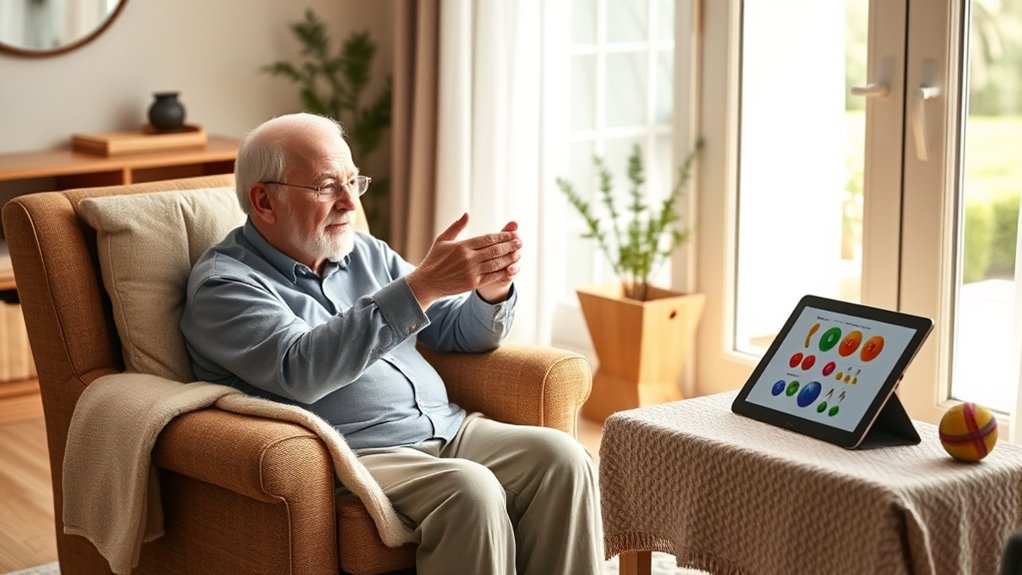To adapt activities for a Parkinson’s patient with limited mobility, focus on customizing exercises to suit their abilities, such as seated yoga or gentle stretching with resistance bands. Incorporate cognitive tasks like puzzles or memory games, and modify routines to include meaningful, manageable tasks. Creating a safe, supportive environment boosts confidence, while positive reinforcement encourages participation. If you want practical tips on making these adaptations work well, keep exploring ways to support their independence.
Key Takeaways
- Modify activities to focus on seated exercises, gentle stretching, and the use of resistance bands or water exercises.
- Incorporate cognitive tasks like puzzles, memory games, and problem-solving to stimulate mental engagement.
- Adapt environments to reduce hazards, enhance safety, and support independence during activities.
- Redesign routines with meaningful, achievable tasks like meal prep or organizing to encourage participation.
- Use positive reinforcement and celebrate small successes to boost motivation and emotional well-being.

Have you ever wondered how everyday activities can be adjusted to better support someone with Parkinson’s? When you’re helping a loved one with limited mobility, small changes can make a significant difference in their comfort and independence. One key area to focus on is exercise modifications. Rather than forcing traditional exercises that may be too demanding or uncomfortable, you can tailor activities to match their current abilities. For example, if walking becomes difficult, consider seated exercises or gentle stretching routines that target flexibility and muscle strength without overexerting them. Using resistance bands, water exercises, or even chair yoga can provide effective alternatives that are easier to perform while still promoting physical health. The goal is to keep them moving without causing fatigue or frustration, which can sometimes lead to decreased motivation.
In addition to physical adjustments, incorporating cognitive engagement into activities proves essential. Parkinson’s often impacts not just movement but also mental sharpness. You can modify activities to stimulate the brain while accommodating mobility limitations. For instance, you might turn simple tasks like sorting objects or assembling puzzles into engaging mental exercises that also encourage fine motor control. Playing memory games, engaging in conversation during activities, or practicing problem-solving tasks can help maintain cognitive function. When you combine cognitive engagement with physical activity, it creates a holistic approach that supports overall well-being. This dual focus can improve mood, enhance focus, and foster a sense of accomplishment, which is crucial for emotional health. Additionally, understanding spatial awareness can help you adapt environments and activities to prevent falls and accidents.
Adapting activities isn’t just about easing physical challenges; it’s also about fostering a sense of participation and independence. You might redesign daily routines to include tasks that are meaningful and achievable, such as preparing simple meals, watering plants, or organizing belongings. These activities can be modified to suit their mobility level, ensuring they stay involved without feeling overwhelmed. Remember to be patient and attentive, offering encouragement and celebrating small successes. This positive reinforcement helps build confidence and motivates continued engagement.
Frequently Asked Questions
How Can I Motivate a Parkinson’s Patient to Try New Activities?
You can motivate a Parkinson’s patient to try new activities by emphasizing cognitive engagement and social interaction. Encourage them with positive reinforcement, highlighting how new activities can stimulate their mind and foster connections. Make activities enjoyable and tailored to their interests, and participate alongside them to boost confidence. Sharing small successes can inspire them to stay engaged, helping them see the benefits and enjoy the process of trying new things.
What Safety Precautions Are Essential During Activity Adaptation?
You should prioritize mobility safety and fall prevention by ensuring the environment is clutter-free, well-lit, and secure. Use sturdy furniture and assistive devices as needed, and always supervise activities to prevent accidents. Additionally, encourage slow, deliberate movements and provide proper footwear. Regularly assess the patient’s condition and adapt the activity accordingly, making safety your top concern to minimize risks and promote confidence during activity adaptation.
How Do I Involve Family in Activity Planning?
You involve family in activity planning by encouraging open communication and asking for their ideas and preferences. Share information about your loved one’s abilities and limitations so they can suggest suitable activities. Invite family members to participate in planning sessions or activities, making them feel engaged and responsible. This collaboration guarantees activities are meaningful, enjoyable, and tailored to the patient’s needs, fostering a supportive environment for their well-being.
Are There Specific Activities Suited for Advanced Parkinson’s Stages?
Yes, in advanced Parkinson’s stages, you can focus on gentle activities like music therapy and art. Music therapy helps soothe and stimulate, while simple art activities like painting or coloring promote expression without requiring mobility. You’ll want to choose activities that are easy to handle, calming, and engaging, encouraging participation without causing frustration. These approaches support emotional well-being and maintain a sense of connection and creativity.
How Can I Monitor Progress and Adjust Activities Accordingly?
You can monitor progress by keeping a daily journal of activity levels and noting any improvements or challenges. Use progress tracking tools like activity logs or wearable devices to gather data objectively. Regularly review this information and modify activities to match your patient’s evolving abilities. Adjust activity intensity, duration, or type based on their response, ensuring they stay engaged without overexertion, fostering steady progress and safety.
Conclusion
While adapting activities for Parkinson’s may seem intimidating at first, it’s ironic how small changes can make a world of difference. You might think limited mobility would limit your options, but often, it’s your creativity that opens new possibilities. So, don’t be discouraged—sometimes, the tiniest adjustments lead to the biggest joys. After all, when life gives you challenges, it’s your adaptability that truly shines. Keep embracing those little wins; they matter more than you think.









